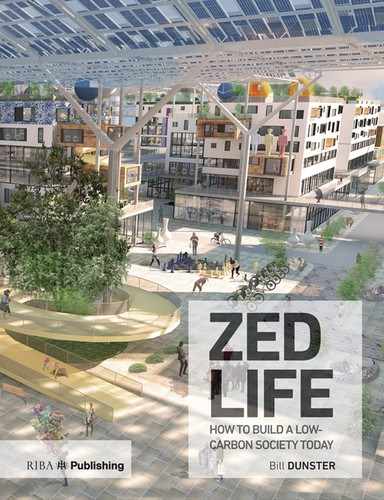Chapter Six
Tool 4
Building-Level Energy Systems: Air-Sourced Heat Pumps and Solar-Assisted Heating and Cooling
Air-sourced heat pump
When a building is super-insulated, the function of the heating system is to provide hot water for kitchen and bathroom use rather than for space heating; the latter can be shrunk by good building fabric and passive solar design, to the point that heat input is only required on the coldest of winter days. The rest of the time, space heating is provided by passive solar gains, internal gains and MVHR (mechanical ventilation with heat recovery) and, when these don’t suffice, very small air-source heat pumps (ASHPs) can be used to provide top-up space heating. ASHPs use an electric powered compressor to circulate refrigerant between coils exposed to both the hot and cold external environment and the internal room. The latent heat of evaporation and liquidification provides heating and cooling on demand – rather like a reversible fridge. The more efficient the system, the less electrical energy is needed to meet thermal demand. Systems as small as 600 W, which use only 1 unit of electricity to provide 3.5 units of heat (average annual efficiency), provide the minimal load of the home while reducing electrical energy. ASHPs can supply warm air, underfloor heating systems and low-flow temperature eco-convector radiators according to choice.
Solar assisted heating and cooling
When the sun is shining you could potentially double the amount of heating and cooling available from conventional ASHPs. Cooling is sometimes forgotten as a consumer of energy in the existing conditions. Indeed, in many eastern cities air conditioning accounts for 70% of the total power load from conventional fossil-fuel powered sources.
This is the method we propose: the heat captured by the solar collector evaporates the refrigerant, thus reducing the amount of electricity required by the compressor motor to run the cooling circuit. This system is relatively simple and easy to maintain with existing materials and components. Making it can be integrated into the external envelope of new and existing buildings alike and make a significant contribution.

6.1 Reversible solar heating/cooling enhanced by evacuated tube balustrade collectors with BIPV facade cladding. One integrated system provides heating in winter, cooling in summer and domestic hot water.
If the solar cooling system can be added to rainscreen BIPV systems, then the building envelope gains another valuable property. It would not only provide heat and electricity but also potentially chilled water, useful for dehumidification in humid climates.
Using solar thermal collector technology in these ways means that solar electricity generated by PV panels and stored in the battery system can now make a comfortable internal environment for most of the year (fig. 6.1). The advantage of this system is that the hotter the sun shines, the more efficient the cooling system becomes. Glazed frameless balconies can be used to mount the vacuum tube solar collectors, or they can be mounted behind clear glazed panels set within a BIPV roof and facade system. This new intelligent skin replaces conventional rainscreen cladding systems and it should be achievable without significant additional cost because the standard alternative is already expensive.
